DIARY of an APIGUARD TREATMENT
Ruary Rudd
Westgate
Waterville
Co. Kerry
On the 7th September 2003, I discovered that Varroa had reached my colonies, by using a 48-hour test with Bayvarol. I found two mites in one colony. Testing the other colonies found no mite fall. In view of the low numbers detected I did not treat any of the colonies that winter.
All my colonies were on open mesh floors with no insert throughout the year except when monitoring was taking place.
The next March (2004) testing for a natural mite drop over three days showed a zero mite fall and so no treatment was called for at that stage.
In the Autumn of 2004, I treated all the colonies with Bayvarol. The strips were inserted on the 17th August and monitoring boards were checked 48 hours after. The heaviest mite drop was only 26 mites. The strips were kept in for the full period and were removed on the 28th September.
In March 2005, I checked natural mite drop in four of my colonies from the 19th to the 24th and got the following results:-
| Colony | Mites |
|---|---|
| 1 | 0 |
| 2 | 1 |
| 4 | 0 |
| 5 | 0 |
Another check in July gave results which, using Richard Ball's figures, [Menu top left] were on the limits between no control and light control. I decided to 'let thing lie' as my colonies were still on Open Mesh floors with no inserts; and that I would treat in the autumn. I would use Apiguard to rotate treatment regimes so as to help delay the onset of 'resistant mites'.
After reading Gerry Murphy's article in the GBBG newsletter The Four Seasons, I made the 20 mm eke and I inserted the thymol gel on the 28th August. I monitored only one hive, colony #1.
| Date | No. of Mites | Remarks |
| 29 Aug | 20 | |
| 30 Aug | 53 | (The bees were bearded on two of the other hives) |
| 31 Aug | 42 | |
| 1 Sep | 52 | (The bees had ceased bearding) |
| 2 Sep | 42 | |
| 3 Sep | 54 | |
| 4 Sep | 66 | (1 mite alive) |
| 5 Sep | 34 | (2 mites alive) |
| 6 Sep | 51 | (2 mites alive) |
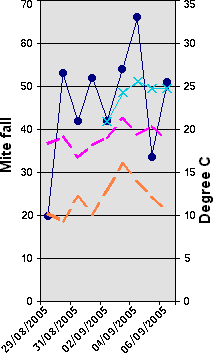
The key to the graphs is shown at right. Mite fall vs date; Max & Min temps vs date; Temperature scale on right axis
Thus far I had a steady kill but there was no sign of a fall in numbers. I decided that it might help if I plotted the mite fall on a graph and used a '5 point moving average to determine the trend.
I decided that I should also plot the maximum and minimum temperatures at the Valentia Observatory, as it is only 8 miles away. These temperatures are available on the Internet. (The temperature scales are on the right of the charts).
Considering that the Apiguard is supposed to be removing mites then, the mite numbers should be dropping day upon day because the remaining population is decreasing.
However, if there was recruitment from hatching cells, this might be the reason why numbers were staying constant. This could have been the case as the numbers included several immature mites (which I wish I had counted separately). If this were so, mites which entered brood cells which were capped on the 28th would be emerging some 12 days later. There should be a drop in numbers after this.
Another cause for worry was the numbers of living mites which I was finding on the insert; was this because the dosage of thymol was becoming too low?
There were 5 more days to go before the second container was inserted and I decided to continue monitoring mite drop hoping things would change. At this stage, I wondered whether, if the mite drop does not fall to zero or near zero at the end of the 6 weeks, I would have to insert Bayvarol to get a % efficiency.
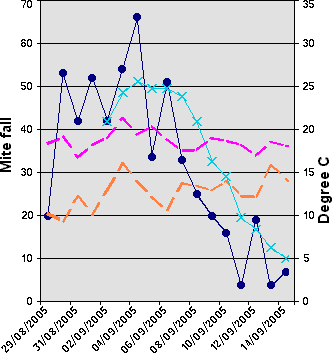
| Date | No. of Mites | Remarks |
| 7 Sept | 33 | (4 alive) |
| 8 Sept | 25 | (2 alive) and I noticed no immature mites |
| 9 Sept | 20 | (1 alive) no immatures |
| 10 Sept | 16 | (1 alive) I noticed that some had been mutilated |
| 11 Sept | 4 | None alive Second trays inserted |
| 12 Sept | 19 | (1 alive) no immature |
| 13 Sept | 4 | None alive |
| 14 Sept | 7 | None alive no immature; bees bearding |
This showed that there was trend of increasing mite fall which after the 6th September changed to a trend of declining numbers.
| Date | No. of Mites | Remarks |
| 15 Sept | 3 | None alive, no immature, bees bearding |
| 16 Sept | 3 | None alive, no immature |
| 17 Sept | 5 | None alive, 1 immature, bees stopped bearding |
| 18 Sept | 5 | Miller Feeders installed and started |
| 19 Sept | 9 | |
| 20 Sept | 2 | Lots of debris on insert, cleaning cells for stores? |
| 21 Sept | 8 | |
| 22 Sept | 2 | Amount of debris reduced |
| 23 Sept | 7 | Amount of debris normal |
| 24 Sept | 0 | |
| 25 Sept | 0 | Very slight amount of debris |
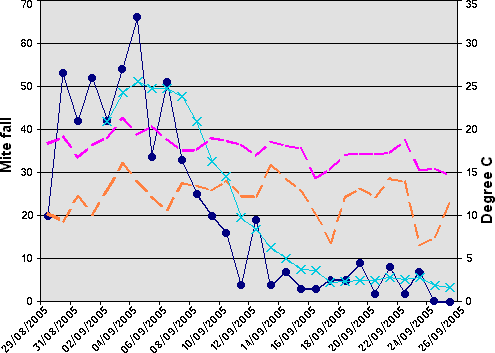
At this stage, although the daily mite drop was showing alarming fluctuations, the moving average was flattening out at about 3 per day, if the Apiguard was working this would have to come down to less than 0.4 or even zero.
As the 24th September was the first day with a zero mite drop This average was feasible.
The Monitoring was continued for the remaining period of treatment.
| Date | No. of Mites | Remarks |
| 26 Sept | 0 | |
| 27 Sept | 1 | |
| 28 Sept | 0 | |
| 29 Sept | 0 | |
| 30 Sept | 0 | |
| 01 Oct | 0 | |
| 02 Oct | 0 | |
| 03 Oct | 0 | |
| 04 Oct | 0 | |
| 05 Oct | 0 | |
| 06 Oct | 0 | |
| 07 Oct | 0 | |
| 08 Oct | 1 | |
| 09 Oct | 1 | end of treatment |
This concluded the treatment period. The hives in the apiary were opened, cover boards and ekes removed, the cover boards and tops of the frames scraped to allow the cover board to fit back tightly.
All inserts were removed and cleaned except for the monitored hive which had the insert replaced so that monitoring could continue.
Any gel remaining on the colonies was removed and collected in a plastic bag. The total weight was 3 1/2 Oz. One colony had cleaned it all, but there was remaining gel on all the other trays.
| Date | No. of Mites | Remarks |
| 10 Oct | 0 | |
| 11 Oct | 0 | |
| 12 Oct | 0 |
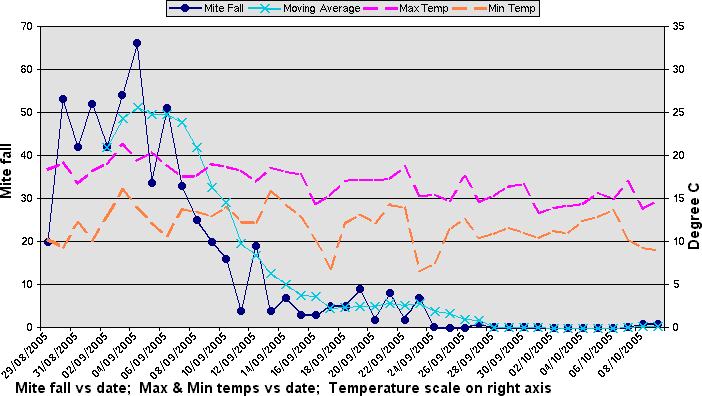
Looking at these results I had a mite fall of two in 15 days at the end of, and just after the treatment period. According to Richard Ball's figures this figure is 15 times less than needed to call for any treatment. I intend to monitor in November and then in March to determine future treatment regimes.
Further monitoring was done in early December: 6 colonies had greased insert installed... A check was done after 10 days. and inserts renewed.
| Hive | Natural mite drop | Remarks |
| 6 | 0 | |
| 5 | 0 | |
| 4 | 0 | |
| 3 | 8 | this colony had a super used as an eke |
| 1 | 0 | |
| 9 | 0 |
There was no reason for any of the colonies to receive any further treatment that winter, and certainly no need for a treatment with Oxalic Acid.
In accordance with the I.P.M regime, monitoring would take place in March of 2006.
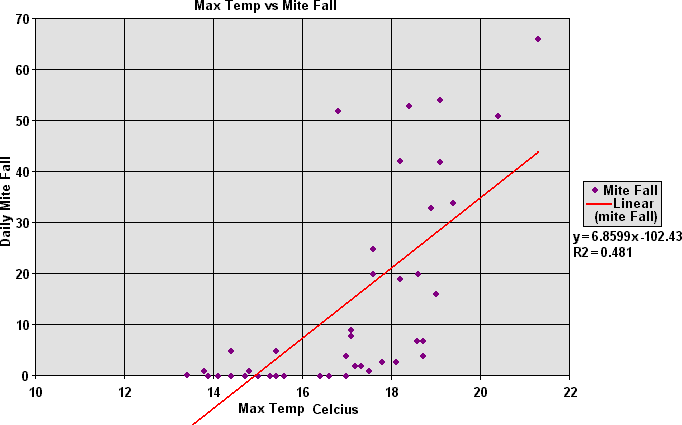
COMMENTS
Apiguard is slower to operate than the synthetic pyrethroids, but must be given time to get to maximum efficiency.
There is no need for an automatic treatment with oxalic acid in the Winter following an Autumn treatment with Apiguard.
The treatment was started later than I would like because of Apimondia 2005 and my desire to monitor the treatment.
Discussion with Vita Ltd was that the surplus gel should have been removed from the trays and spread on aluminised card and then left for the bees to remove completely.
A graph of Max Daily Temperature vs Mite drop indicated a very strong correlation with a zero mite drop expected if the Max Temperature was lower than 15.2 degrees. This agrees with Vita's parameter of the max daily temperature greater than 15 degrees.
| Hive 1 | = | 0 | Hive 5 | = | 1 | |
|---|---|---|---|---|---|---|
| Hive 2 | = | 0 | Hive 6 | = | 1 | |
| Hive 3 | = | 2 | Hive 9 | = | 0 | |
| Hive 4 | = | 1 | Hive 10 | = | 1 |
6th February 2006
The final instalment was finished today when I completed an eight day monitoring of natural mite fall. The results were:-
All in all very satisfactory and these results show that Apiguard works and that there is no need for an automatic follow up treatment with oxalic acid in mid winter.
Ruary Rudd